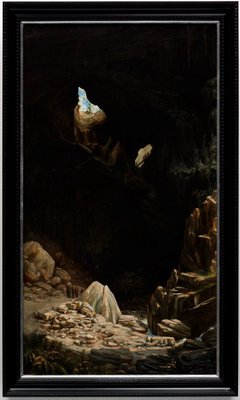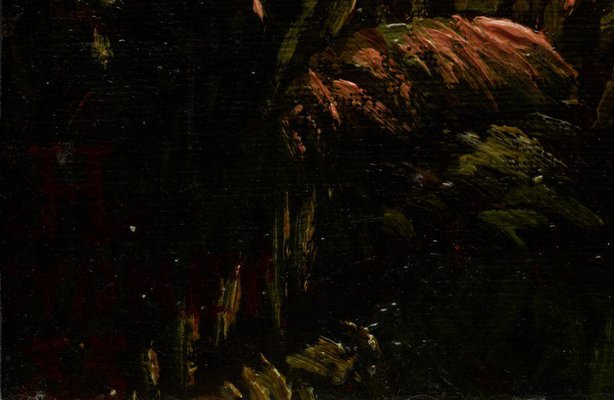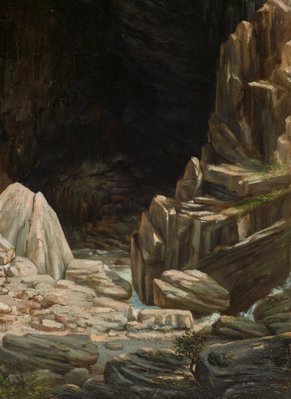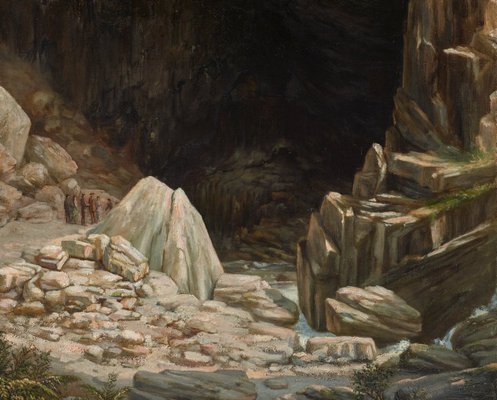






-
Details
- Other Title
- Devil's coachouse, Fish River Caves
- Date
- 1883
- Media category
- Painting
- Materials used
- oil on canvas
- Dimensions
- 116.2 x 65.2 cm stretcher; 126.8 x 75.9 x 7.0 cm frame
- Signature & date
Signed and dated l.l. corner, brown oil "HL [monogram]/ .../ 83".
- Credit
- Marshall Bequest Fund 1979
- Location
- South Building, ground level, Grand Courts
- Accession number
- 459.1979
- Copyright
- Artist information
-
Lucien Henry
Works in the collection
- Share
-
-
About
'Devil’s Coach-house, Fish River Caves' depicts the Jenolan Caves, located to the west of the Blue Mountains, in Gundungurra Country. Jenolan is an Aboriginal word meaning ‘high place’ and the caves were renamed as such in August 1884. This extensive network of limestone caves belong to the Burra who know them as Binomil or Binoomur. They first came to the attention of colonisers around 1838 through the
discovery of a large open cavern, now known as the ‘Devil’s Coach-house’.At the time of Henry’s painting, the caves had become a popular tourist destination. An 1880 correspondent noted of the caves that ‘this place is most imposing and awe inspiring. One could fancy seeing engraved deeply into the rocks the words “Lasciate ogni Speranza” [abandon all hope], as in Dante’s Inferno’. The theme of the infernal was not lost to Henry, having previously painted Dante’s underworld during his seven-year imprisonment in the French penal colony on Kanak Country in Nouméa, New Caledonia.
-
Exhibition history
Shown in 7 exhibitions
Fourth Annual Exhibition of the Art Society of New South Wales (1883), Sydney Town Hall, Australia, 01 Oct 1883 -
Visions of Federation, Powerhouse Museum, Ultimo, 03 Apr 2001–14 Oct 2001
Visions of a republic: the work of Lucien Henry, Powerhouse Museum, Ultimo, Apr 2001 -
Shaded, Dubbo Regional Art Gallery, Dubbo, 28 Aug 2017–03 Dec 2017
Obsession: devil in the detail, Mornington Peninsula Regional Gallery, Mornington, 30 Nov 2018–17 Feb 2019
Fieldwork, Hawkesbury Regional Gallery, Windsor, 17 Jul 2020–20 Sep 2020
Fieldwork, Maitland Regional Art Gallery, Maitland, 28 Nov 2020–07 Feb 2021
Fieldwork, Penrith Regional Gallery & The Lewers Bequest, Emu Plains, 12 Mar 2021–09 May 2021
Grand Courts collection rehang, Art Gallery of New South Wales, Sydney, Nov 2021–2023
-
Bibliography
Referenced in 6 publications
-
Terry Ingram, Australian Financial Review, 'Lost cave painting sees new light of day', pg. 21, Sydney, 13 Sep 1979, 21.
-
Danny Lacy (Curator), Obsession: devil in the detail, 2018, 6 (detail) (colour illus.), 7, 9 (colour illus.), 89.
-
Adrian Mitchell, Plein airs and graces: the life and times of George Collingridge, 'The Promised Land', pg. 48-61, Kent Town, 2012, 57.
-
Royal Art Society of New South Wales, Art Society of New South Wales Fourth Annual Exhibition Catalogue, Sydney, 1883, 8. cat.no. 43; priced £105-0-0
-
Ann Stephen, Natalie Adamson, Anne Watson and Charles Pickett, Visions of a Republic: the work of Lucien Henry, Haymarket, 2001, 60, 61 (colour illus.), 62.
-
Editor Unknown (Editor), The Sydney Morning Herald, 'The Art Society's exhibition.', Sydney, 04 Oct 1883, 8. exhibition review
-


